
A P P L I C AT I O N N O T E
E C ON E T EC +/E C ++ E th e rn e t & W iF i C on figu ra t ion
A P N t 0 2 4 E CW E C
E N R e v .1 .0 3
T U R B O s . r .l .
D u s t F i l t e r C o m p o n e n t s
V i a C e n t r o I n d u s t r i a l e E u r o p e o , 3 3
–
T u r a t e ( C O ) I t a l y
T e l + + 3 9 0 3 6 2 5 7 4 0 2 4 F a x + + 3 9 0 3 6 2 5 7 4 0 9 2
2
Introduction
This application note provides information about configuration methods and features for WiFi® and Ethernet
plug-in communication boards for Econet EC+/EC++ family.
The Turbo plug-in communication boards are available in three mounting variant: WiFi, Ethernet and WiFi +
Ethernet. They are fully compatible with EC+ and EC++ Econet devices and have an on-board TCP/IP stack for
ready-to-use interfacing at standard industrial networks.
Plug-In communication boards
Based on the “Plug
-in Communication boar
ds” are made up of a small board fitted into the Econet EC+/EC++
mainboards.
Developed around a single electronic board fitted in different variants, the communication board is mounted
on the Econet EC+/EC++ motherboard. It is provided of an high performances microcontroller that handles a
communication module. Thanks to its smart technology, the module takes care of handling all the information
exchange tasks on the network.
Once the initial configuration has been performed, the Plug-In communication board automatically accesses at
WiFi or Ethernet network and sends/receives serial data.
The WiFi version is based on Microchip RN171 stand-alone embedded wireless LAN access device module.
The Ethernet version is based on Lantronix® DeviceLinx® XPort® device server module.
Here are listed the main Plug-In communication board features:
Ethernet board
WiFi board
Connects devices through a TCP data channel or through
a Telnet connection
Fully qualified and Wi-Fi certified 2.4 GHz IEEE 802.11 b/g transceiver
Supports UDP datagrams
FCC, CE, IC certified
Contains a web [HTTP] server allowing presentation of custom
content and easy configuration through a browser.
4 μA sleep, 35 mA RX, 185 mA TX at 12 dBm
(TX power
is
configurable)
ARP, UDP, TCP, ICMP, Telnet, TFTP, AutoIP, DHCP, HTTP, and
SNMP for network communications and management.
On-board TCP/IP stack
TCP, UDP, and Telnet for connections to the serial port.
Output Power: 12dBm (programmable)
IP for addressing, routing, and data block handling over the
network.
Secure Wi-Fi authentication via WEP, WPA-PSK (TKIP), and
WPA2-PSK (AES)
User Datagram Protocol (UDP) for typical datagram applications
External antenna
































